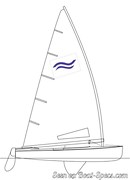Finn
Sailboat specifications
The Finn is a 14’10” (4.5m) dinghy designed by Rickard Sarby (Sweden). She is built since 1949 by Devoti Sailing (Czech Republic).
Finn's main features
- Model
- Finn
- Hull type
- Monohull
- Category
- Dinghy
- Sailboat builder
- Sailboat designer
- Sailboat collection
- Country
- Czech Republic
- Construction
- Hull and deck: GRP (glass reinforced polyester)
- First built hull
- 1949
- Last built hull
- Still in production
- Appendages
- Centerboard : pivoting centerboard
- Helm
- Single tiller
- Rudder
- Single transom hung rudder
- Unsinkable
- No
- Trailerable
- Yes
- Standard public price ex. VAT (indicative only)
- About14 600 €(2020)
Finn's main dimensions
- Hull length
- 14’ 10”4.5 m
- Waterline length
- 11’3.34 m
- Beam (width)
- 4’ 10”1.47 m
- Draft
- 2’ 10”0.85 m
- Draft when appendages up
- 0’ 7”0.17 m
- Light displacement (MLC)
- 256 lb116 kg
Finn's rig and sails
- Upwind sail area
- 114 ft²10.6 m²
- Mainsail area
- 114 ft²10.6 m²
- Rigging type
- Cat boat Marconi
- Mast configuration
- Mast foot integrated on deck
- Rotating spars
- No
- Spreaders angle
- No spreader
- Spars construction
- Carbon fiber spars
- Standing rigging
- Free standing mast: no standing rigging
Finn's performances
- Crew
- 1
- PY (Portsmouth Yardstick) ratingiPortsmouth Yardstick is an empirical rating system allowing small sailboats (dinghies included), of different sizes and designs, to race each other fairly. Therefore, by comparing these values, we can have an indication of the relative speed of 2 boats.
- 1060
- D-PN ratingiDPN is a variation of Portsmouth Yardstick used in the United States.
- 90.1
- Upwind sail area to displacementiThe ratio sail area to displacement is obtained by dividing the sail area by the boat's displaced volume to the power two-thirds.
The ratio sail area to displacement can be used to compare the relative sail plan of different sailboats no matter what their size.
Upwind: under 18 the ratio indicates a cruise oriented sailboat with limited performances especially in light wind, while over 25 it indicates a fast sailboat. - 480 ft²/T44.57 m²/T
- Displacement-length ratio (DLR)iThe Displacement Length Ratio (DLR) is a figure that points out the boat's weight compared to its waterline length. The DLR is obtained by dividing the boat's displacement in tons by the cube of one one-hundredth of the waterline length (in feet).
The DLR can be used to compare the relative mass of different sailboats no matter what their length:
a DLR less than 180 is indicative of a really light sailboat (race boat made for planning), while a DLR greater than 300 is indicative of a heavy cruising sailboat. - 88
- Critical hull speediAs a ship moves in the water, it creates standing waves that oppose its movement. This effect increases dramatically the resistance when the boat reaches a speed-length ratio (speed-length ratio is the ratio between the speed in knots and the square root of the waterline length in feet) of about 1.2 (corresponding to a Froude Number of 0.35) . This very sharp rise in resistance, between speed-length ratio of 1.2 to 1.5, is insurmountable for heavy sailboats and so becomes an apparent barrier. This leads to the concept of "hull speed".
The hull speed is obtained by multiplying the square root of the waterline length (in feet) by 1.34. - 4.44 knots
Finn's auxiliary engine
- Engine(s)
- No engine
Finn's accommodations and layout
- Cockpit
- Closed aft cockpit



Devoti Sailing Finn sailplan - - 2/5
Picture extracted from the commercial documentation © Devoti Sailing
Picture extracted from the commercial documentation © Devoti Sailing


Devoti Sailing Finn sailing - - 3/5
Picture extracted from the commercial documentation © Devoti Sailing
Picture extracted from the commercial documentation © Devoti Sailing


Devoti Sailing Finn sailing - - 4/5
Picture extracted from the commercial documentation © Devoti Sailing
Picture extracted from the commercial documentation © Devoti Sailing


Devoti Sailing Finn sailing - - 5/5
Picture extracted from the commercial documentation © Devoti Sailing
Picture extracted from the commercial documentation © Devoti Sailing
Similar sailboats that may interest you:
Sailboats
First built hull
Hull length
1995
13’ 1”4 m
2015
14’ 1”4.29 m
1995
11’ 6”3.5 m
1998
14’ 7”4.44 m
1997
12’ 10”3.89 m
1997
14’ 2”4.32 m
1983
14’ 2”4.32 m
1994
16’ 4”4.98 m
2008
14’ 6”4.42 m
2003
14’ 6”4.42 m
2017
11’ 10”3.59 m
2010
16’ 4”4.98 m
1995
15’ 2”4.64 m
1999
17’5.18 m
1981
14’ 5”4.4 m